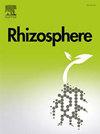Short-term nitrogen enrichment induces sulfide intrusion in tropical oligotrophic seagrass meadows
IF 3.5
3区 生物学
Q1 PLANT SCIENCES
引用次数: 0
Abstract
Sediment sulfide stress on seagrasses is related to anthropogenic nutrient enrichment and substrate type (e.g., sandy or muddy). This study investigated if anthropogenic nitrogen (N) enrichment resulted in sulfide stress in tropical seagrass Thalassia hemprichii inhabiting sandy habitats. Anthropogenic input resulted in 3.4-fold increase in sediment δ15N, and increase in the sediment organic matter and fine fraction content. N enrichment increased sediment sulfur (S) content and caused higher δ34S depletion in sediment. Higher N availability contributed towards significant increase of T. hemprichii shoot density and leaf biomass. Conversely, it reduced the root biomass, and root branching index coinciding with depleted root δ34S values. Additionally, in the sandy sediments the sediment Fe levels were lower than pristine conditions, suggesting Fe limitation and subsequent increased sediment sulfide intrusion into T. hemprichii roots. This highlights T. hemprichii growing in sandy sediments with low Fe levels are more prone to sulfide intrusion under N enrichment.
短期氮富集诱导热带少营养海草草甸硫化物入侵
沉积物硫化物对海草的胁迫与人为营养物富集和基质类型(如砂质或泥质)有关。摘要本研究探讨了热带海草(Thalassia hemprichii)在沙质生境中是否因人为氮(N)富集而导致硫化物胁迫。人为输入导致沉积物δ15N增加3.4倍,沉积物有机质和细粒组分含量增加。N的富集增加了沉积物硫(S)含量,导致沉积物δ34S耗损增大。较高的氮素有效性显著提高了麻蝇的芽密度和叶片生物量。相反,它降低了根生物量,根分枝指数与耗尽的根δ34S值一致。此外,在砂质沉积物中,沉积物铁含量低于原始状态,表明铁限制和随后沉积物硫化物侵入麻刺虫根。这说明在富氮条件下,生长在低铁含量砂质沉积物中的麻孔绦虫更容易发生硫化物侵入。
本文章由计算机程序翻译,如有差异,请以英文原文为准。
求助全文
约1分钟内获得全文
求助全文
来源期刊

Rhizosphere
Agricultural and Biological Sciences-Agronomy and Crop Science
CiteScore
5.70
自引率
8.10%
发文量
155
审稿时长
29 days
期刊介绍:
Rhizosphere aims to advance the frontier of our understanding of plant-soil interactions. Rhizosphere is a multidisciplinary journal that publishes research on the interactions between plant roots, soil organisms, nutrients, and water. Except carbon fixation by photosynthesis, plants obtain all other elements primarily from soil through roots.
We are beginning to understand how communications at the rhizosphere, with soil organisms and other plant species, affect root exudates and nutrient uptake. This rapidly evolving subject utilizes molecular biology and genomic tools, food web or community structure manipulations, high performance liquid chromatography, isotopic analysis, diverse spectroscopic analytics, tomography and other microscopy, complex statistical and modeling tools.
 求助内容:
求助内容: 应助结果提醒方式:
应助结果提醒方式:


